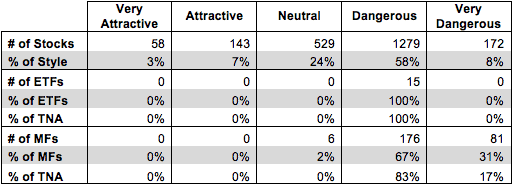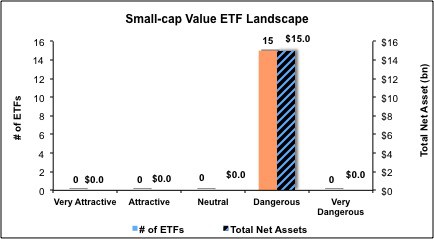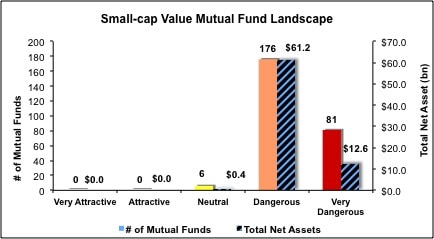The Small Cap Value style ranks twelfth out of the twelve fund styles as detailed in my Style Rankings for ETFs and Mutual Funds report. It gets my Dangerous rating, which is based on aggregation of ratings of 15 ETFs and 263 mutual funds in the Small Cap Value style as of January 30, 2014. Prior reports on the best & worst ETFs and mutual funds in every sector and style are here.
Figures 1 and 2 show the five best and worst-rated ETFs and mutual funds in the style. Not all Small Cap Value style ETFs and mutual funds are created the same. The number of holdings varies widely (from 21 to 1637), which creates drastically different investment implications and ratings. The best ETFs and mutual funds allocate more value to Attractive-or-better-rated stocks than the worst, which allocate too much value to Neutral-or-worse-rated stocks.
To identify the best and avoid the worst ETFs and mutual funds within the Small Cap Value style, investors need a predictive rating based on (1) stocks ratings of the holdings and (2) the all-in expenses of each ETF and mutual fund. Investors need not rely on backward-looking ratings. My fund rating methodology is detailed here.
Investors should not buy any Small Cap Value ETFs or mutual funds because none get an Attractive-or-better rating. If you must have exposure to this style, you should buy a basket of Attractive-or-better rated stocks and avoid paying undeserved fund fees. Active management has a long history of not paying off.
Get my ratings on all ETFs and mutual funds in this style by searching for Small Cap Value on my free mutual fund and ETF screener.
Figure 1: ETFs with the Best & Worst Ratings – Top 5
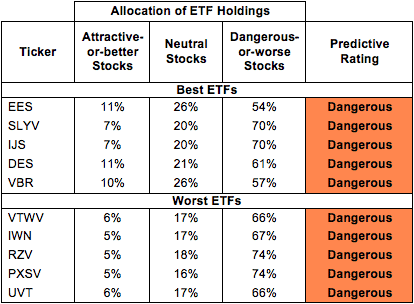 * Best ETFs exclude ETFs with TNAs less than $100 million for inadequate liquidity.
* Best ETFs exclude ETFs with TNAs less than $100 million for inadequate liquidity.
Sources: New Constructs, LLC and company filings
Four ETFs are excluded from Figure 1 because their total net assets (TNA) are below $100 million and do not meet our liquidity standards. The excluded ETFs can be found here.
Figure 2: Mutual Funds with the Best & Worst Ratings – Top 5
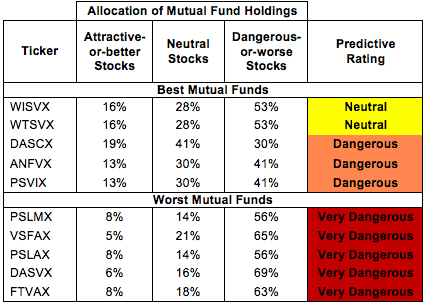 * Best mutual funds exclude funds with TNAs less than $100 million for inadequate liquidity.
* Best mutual funds exclude funds with TNAs less than $100 million for inadequate liquidity.
Sources: New Constructs, LLC and company filings
Six ETFs are excluded from Figure 2 because their total net assets (TNA) are below $100 million and do not meet our liquidity standards. The excluded ETFs can be found here.
WisdomTree SmallCap Earnings Fund (EES) is my top-rated Small Cap Value ETF and Westcore Trust: Westcore Small-Cap Value Dividend Fund (WISVX) is my top-rated Small Cap Value mutual fund. EES earns my Dangerous rating and WISVX earns my Neutral rating.
ProShares Ultra Russell2000 Value (UVT) is my worst-rated Small Cap Value ETF and Touchstone Strategic Trust: Touchstone Small Company Value Fund (FTVAX) is my worst-rated Small Cap Value mutual fund. UVT earns my Dangerous rating and WISVX earns my Very Dangerous rating.
Figure 3 shows that 201 out of 2181 stocks (over 10% of the market value) in Small Cap Value ETFs and mutual funds get an Attractive-or-better rating. However, 0 out of 15 Small Cap Value ETFs and 0 out of 263 Small Cap Value mutual funds get an Attractive-or-better rating.
The takeaways are: mutual fund managers allocate too much capital to low-quality stocks and Small Cap Value ETFs hold poor quality stocks.
Figure 3: Small Cap Value Style Landscape For ETFs, Mutual Funds & Stocks
As detailed in “Low-Cost Funds Dupe Investors”, the fund industry offers many cheap funds but very few funds with high-quality stocks, or with what I call good portfolio management.
Investors need to tread carefully when considering Small Cap Value ETFs and mutual funds, as the amount of Dangerous-or-worse rated funds is very high. No ETFs or mutual funds in the Small Cap Value style allocate enough value to Attractive-or-better-rated stocks to earn an Attractive rating. Investors should focus on individual stocks instead.
Schweitzer-Mauduit International, Inc. (SWM) is one of my favorite stocks held WISVX and earns my Attractive rating. Over the past six years, SWM has increased after tax profit (NOPAT) by 37% compounded annually. The company currently earns a top quintile return on invested capital (ROIC) of 16%. However, the market has failed to realize to true value of SWM. At ~$45/share, SWM has a price to economic book value (PEBV) ratio of 1.1. This ratio implies that the market expects SWM to increase NOPAT by only 10% for the remainder of its corporate life. Low expectations and consistently high profit growth make SWM an attractive opportunity.
Granite Construction, Inc. (GVA) is one of my least favorite stocks held by FTVAX and earns my Dangerous rating. Over the past seven years, GVA’s NOPAT has decreased by 11% compounded annually. During this same timeframe, GVA’s ROIC has declined from 14% to 5%. Despite the negative growth and decline in profitability, the market has overestimated the value of GVA. Its current valuation of ~$34/share implies that GVA will grow NOPAT by 15% compounded annually for the next 29 years. To believe in GVA, one must assume the company can completely turn around their declining NOPAT and grow rapidly in the competitive, low margin construction business. I believe expectations embedded in the stock price are far too optimistic and investors should avoid GVA.
Figures 4 and 5 show the rating landscape of all Small Cap Value ETFs and mutual funds.
My Style Rankings for ETFs and Mutual Funds report ranks all styles and highlights those that offer the best investments.
Figure 4: Separating the Best ETFs From the Worst Funds
Figure 5: Separating the Best Mutual Funds From the Worst Funds
Review my full list of ratings and rankings along with reports on all 15 ETFs and 263 mutual funds in the Small Cap Value style.
Kyle Guske II contributed to this report.
Disclosure: David Trainer and Kyle Guske II receive no compensation to write about any specific stock, sector, style or theme.

